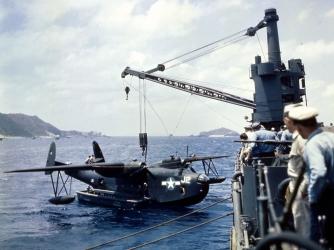
Under normal circumstances, pilots lost in the Atlantic were supposed to point their planes toward the setting sun and fly west toward the mainland, but Taylor had become convinced that he might be over the Gulf of Mexico. Hoping to locate the Florida peninsula, he made a fateful decision to steer Flight 19 northeast—a course that would only take them even farther out to sea. Some of his pilots seemed to have recognized that he was making a mistake. “Dammit,” one man griped over the radio. “If we would just fly west, we would get home.”

Taylor was eventually persuaded to turn around and head west, but shortly after 6 p.m., he seems to have canceled the order and once again changed direction. “We didn’t go far enough east,” he said, still worried that he might be in the Gulf. “We may as well just turn around and go east again.” His pilots probably argued against the decision—some investigators even believe that one plane broke off and flew in a different direction—but most followed their commander’s lead. Flight 19’s radio transmissions soon became increasingly faint as it meandered out to sea. When fuel began to run low, Taylor was heard prepping his men for a potential crash landing in the ocean. “All planes close up tight,” he said. “We’ll have to ditch unless landfall…when the first plane drops below ten gallons, we all go down together.” A few minutes later, the Avengers’ last radio communications were replaced by an eerie buzz of static.
[embedded content]
The Search Comes Up Short
The Navy immediately scrambled search planes to hunt for the missing patrol. Around 7:30 p.m., a pair of PBM Mariner flying boats took off from an air station north of Ft. Lauderdale. Just 20 minutes later, however, one of them seemed to follow Flight 19’s lead by suddenly vanishing off the radar.
The remains of the Mariner and its 13 crewmen were never recovered, but it’s commonly believed that the seaplane exploded shortly after takeoff. Flying boats were notoriously accident-prone, and were even nicknamed “flying gas tanks” for their propensity for catching fire. Suspicions that the seaplane may have gone up in flames were all but confirmed by a passing merchant ship, which spotted a fireball and found evidence of an oil slick in the ocean.

At first light the next day, the Navy dispatched more than 300 boats and aircraft to look for Flight 19 and the missing Mariner. The search party spent five days combing through more than 300,000 square miles of territory, to no avail. “They just vanished,” Navy Lieutenant David White later recalled. “We had hundreds of planes out looking, and we searched over land and water for days, and nobody ever found the bodies or any debris.”





